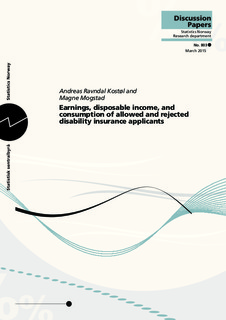| dc.contributor.author | Kostøl, Andreas Ravndal | |
| dc.contributor.author | Mogstad, Magne | |
| dc.coverage.spatial | Norway | nb_NO |
| dc.date.accessioned | 2019-11-11T09:32:28Z | |
| dc.date.available | 2019-11-11T09:32:28Z | |
| dc.date.issued | 2015-03 | |
| dc.identifier.issn | 1892-753X | |
| dc.identifier.uri | http://hdl.handle.net/11250/2627604 | |
| dc.description.abstract | Two key questions in thinking about the size and growth of the disability insurance program are to what extent it discourages work, and how valuable the insurance is to individuals and families. These questions motivate our paper. We begin by describing the earnings, disposable income and consumption of awarded and rejected DI applicants, before and after the disability onset and the allowance decision. Next, we discuss how these descriptive results can be interpreted through the lens of alternative empirical approaches. Our analysis uses a Norwegian population panel data set with detailed information about every individual and household. | nb_NO |
| dc.description.sponsorship | Norwegian Research Council. | nb_NO |
| dc.language.iso | eng | nb_NO |
| dc.publisher | Statistisk sentralbyrå | nb_NO |
| dc.relation.ispartofseries | Discussion papers;803 | |
| dc.subject | JEL classification: I38 | nb_NO |
| dc.subject | JEL classification: J62 | nb_NO |
| dc.subject | JEL classification: H53 | nb_NO |
| dc.title | Earnings, disposable income, and consumption of allowed and rejected disability insurance applicants | nb_NO |
| dc.type | Working paper | nb_NO |
| dc.description.version | publishedVersion | nb_NO |
| dc.subject.nsi | VDP::Matematikk og Naturvitenskap: 400::Matematikk: 410::Statistikk: 412 | nb_NO |
| dc.source.pagenumber | 9 | nb_NO |
